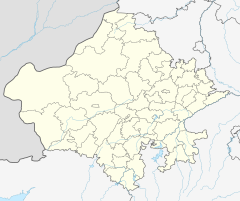Jagdish Temple is a large Hindu temple in the middle of Udaipur in Rajasthan, just outside the royal palace. It has been in continuous worship since 1651. A big tourist attraction, the temple was originally called the temple of Jagannath Rai but is now called Jagdish-ji. It is a major monument in Udaipur.[1]
| Jagdish Temple | |
|---|---|
 | |
| Religion | |
| Affiliation | Hinduism |
| District | Udaipur district |
| Location | |
| Location | Udaipur |
| State | Rajasthan |
| Country | India |
| Geographic coordinates | 24°34′47.4024″N 73°41′1.899″E / 24.579834000°N 73.68386083°E |
Overview
editThe Jagdish Temple is raised on a tall terrace and was completed in 1651. It attaches a double-storey Mandapa (hall) to a double-storey saandhara (with a covered ambulatory) sanctum. The mandapa has another storey tucked within its pyramidal samavarna (bellroof) while the hollow clustered spire over the sanctum contains two more, nonfunctional stories. To reach the main shrine, one must climb 32 marble steps, intercepted by a Brass image of Garuda in the end, being the mount (vahana) of God Vishnu. Shri Jagdish Temple is the most beautiful example of Hindu Iconography, consisting of three stories of hand carved stone, with a steeple nearly 79 feet high and is the largest temple of Udaipur.[2]
Lanes taking off from many of the sheharpanah (city wall) converge on the Jagdish Temple. The most beautiful event in the temple is the annual Rath Yatra.[3] It was built by Maharana Jagat Singh in 1651.[4] Jagdish Temple is a splendid example of either Māha Māru or Māru-Gurjara architecture,[5] decorated by beautiful and ornate carvings. A short walk from the city palace will bring you to this temple. The temple sanctum has an idol of the deity Lord Jagannath, in local parlance of God Vishnu or God Krishna, carved out of a single black stone, resplendent with four arms, flowers and finery.[6] Four smaller shrines, dedicated to Lord Ganesha, Surya, Goddess Shakti and Lord Shiva form a circle around the main shrine, housing the idol of Lord Vishnu. It is said that an estimated RS 1.5 million (or 1,500,000) ($22023. 21) was spent to construct the building in 1651.
battle of udaipur
editAurangzeb attacked Mewar and plundered Udaipur, the citizens were safely escorted to Panarwa a hilly region by Rana Raj Singh but 63 temples in and around Udaipur were plundered and many villages were burned down by Aurangzeb's general Taj Khan. The Mughal army was eventually starved because of the scorched earth techniques and guerrilla warfare used by the Rana. Aurangzeb after a failed campaign left Mewar to his son Akbar and retreated to Ajmer.during that time naruji barhath a charan warrior fought bravely to protect jagdish mandir from Aurangzeb army. He martyred himself while fighting to mughal army[7] [8][9]
Gallery
edit-
Elephant carvings on Jagdish Mandir
-
Women during a prayer
-
Mural Statues and Sculptures
-
festive decorations
-
Painting by John Gleich (1879 - c.1927)
-
Sculptures on wall. Instrument resembling Rudra veena, far left.
-
Sculptures of musicians and dancers.
-
God Shiva in the temple.
-
Stone inscription about the temple.
References
edit- ^ "Jagdish Temple". udaipur.org.uk. Udaipur India. Retrieved 5 September 2016.
- ^ Shri Jagdish Temple, the Largest Temple in Udaipur, Rajasthan
- ^ Devotees celebrate 142nd Jagannath Rath Yatra in different parts of country[1]
- ^ "My Kind of Place: Udaipur, India". thenational.ae. thenational. 23 February 2016. Retrieved 5 September 2016.
- ^ Bose, Melia Belli (1997). Royal Umbrellas of Stone: Memory, Politics, and Public Identity in Rajput Funerary. BRILL. ISBN 9004300562.
- ^ "Udaipur - The City of Lakes". trayaan.com. 2 December 2015. Retrieved 5 October 2016.
- ^ It was resisted by 20 warriors of Mewar under the leadership of Naruji and all were killed fighting. http://www.eternalmewar.in/research
- ^ Aurangzeb attacked Mewar and plundered Udaipur, the citizens were safely escorted to Panarwa a hilly region by Rana Raj Singh but 63 temples in and around Udaipur were plundered and many villages were burned down by Aurangzeb's general Taj Khan. The Mughal army was eventually starved because of the scorched earth techniques and guerrilla warfare used by the Rana. Aurangzeb after a failed campaign left Mewar to his son Akbar and retreated to Ajmer.http://etd.lib.jnu.ac.in/TH17242.pdf
- ^ Another example , this time from the Caran community , is the aforemen- tioned Naruji , whose death at the hands of Aurangzeb's soldiers is held to re- flect the glory of the Mewar royal family . The 78 THE GODDESSES ' HENCHMEN.https://books.google.co.in/books?id=Ono8DwAAQBAJ&printsec=copyright&redir_esc=y#v=onepage&q=Naruji&f=false
